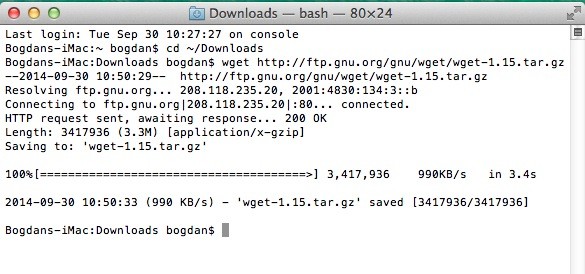Download Wget For Mac Os
Install wget on Mac OS X. In simple words, it is a command to download file from a given URL and port. Most Linux users and some windows users are familiar to this handy command download tool and on most Linux distributions it is pre-installed, but on Max OSX it. I update mac to Sierra, 10.12.3. My wget stop working. When I tried to install by typing. Brew install wget -with-libressl I got the following warning. Warning: wget-1.19.1 already installed, it's just not linked. Then tried to unsintall by typing. Brew uninstall wget -with-libressl Then I reinstalled by typing. Brew install wget.
The wget command is used to download files from the web and is one of the most useful commands around. But while it comes included with most distributions of Linux, it is not built into Mac OS X by default. Therefore, let’s look at installing wget.To get started, install the developer tools for Mac OS X so that you can get a working copy of a compiler (gcc). Once the developer tools have been installed, you’ll want to download the latest version of wget from gnu. To do so, either download it manually from http://www.gnu.org/software/wget or use the ftp command to do so for you:Express VPN Best for privacy. Number of IP addresses: 30,000 Number of servers: 3,000+ 3 months free with 1-year plan. Note: Due to the use of nodejs instead of node name in some distros, yarn might complain about node not being installed. A workaround for this is to add an alias in your.bashrc file, like so: alias node=nodejs.This will point yarn to whatever version of node you decide to use. If Yarn is not found in your PATH, follow these steps to add it and allow it to be run from anywhere.
ftp ftp://ftp.gnu.org/gnu/wget/wget-latest.tar.gzNext, extract the tar file using the tar command:

tar -xvzf wget-latest.tar.gzYou will then have a directory called wget- followed by the version of wget you just downloaded (currently 1.12). Let’s cd into that directory:
cd wget-1.12Then run the configure script:
./configureThen make the installer:
makeThen run the installer (with elevated privileges:
make installYou will then have the wget command located in /usr/local/bin/wget. To use it, simply use wget, followed by the path to the file you’d like to download using the –tries option:
wget –tries=10 https://krypted.com//scripts/wget.sh
Mac Wget Command Not Found
There are a lot of options for wget, but some that I use more than others include –user= and –password=, which allows you to authenticate to a host by specifying a username and a password (respectively of course) and –limit-rate, which funny enough, let’s you throttle the speeds of transfers so as not to saturate your bandwidth. I also frequently need to use the -r operator, which allows for recursive downloads and the -o operator which outputs to a log file. Overall wget is one of the most useful commands around, and hopefully after reading this you’ll download it and get used to using it (if you weren’t already).When working with Linux, especially on the professional and enterprise environment, there’s always the necessity of downloading a number of files from the internet time to time. Especially in the professional environment that requires a lot of scripting, a suitable download manager is always welcome.For the enterprise, RHEL is the most suitable one as it’s well maintained with tons of support from both the community and the developers. CentOS, on the other hand, is the free edition of RHEL that offers a great ground for practicing and getting a grab of the enterprise environment.
Are you a CentOS user? So am I! I recently started my journey with CentOS on my virtual machine.
For scripting and other purposes, “wget” is an extremely suitable choice. Wget is a part of the GNU Project software that offers a very basic download manager. It’s free and open-source and capable of handling all the popular Internet protocols like HTTP, HTTPS, FTP and FTPS.

Wget is a non-interactive command-line tool. That makes it extremely suitable for almost any purpose. Let’s get wget in our CentOS!
By default, CentOS should come up with wget. Make sure that your system comes up with wget by running the following command –
If you didn’t get the result, you should install wget into your system right now!
Installing Wget
There are 2 different ways of installing wget into your system – installing from CentOS repository or, building it from source.
Grabbing wget from CentOS repo
At first, make sure that your system is up-to-date –

Download Wget For Mac Os Versions
Then, run the command for installing wget –
- Installing from source
This method applies to all the other Linux distros as well. We have to grab the source code and build it in our system.
Make sure that your CentOS system comes up with all the necessary development tools –
sudoyum install glibc-devel glibc-headers kernel-headers kernel-devel gnutls-devel
Grab the source code from the official GNU FTP server –
Then, extract the source code –
Now, start the building process –
Finally, perform the installation –
Wget usage
Wget is a very simple tool to use. Generally, all you need to tell is the download link of the file. For example, let’s download the source code of “wget” once again –

There are also a number of other advanced options available. For example, you can set the file name of the download into a different one using “-O” flag.
Mac Os X Wget
Need to download multiple files? Just state their respective download URLs one after another!
Wget Download Mac Os X
It’s also possible to download all the links from a file. For example,
https://ftp.gnu.org/gnu/wget/wget-1.6.tar.gz
https://ftp.gnu.org/gnu/wget/wget-1.7.tar.gz
Now, tell wget to use the file as the source of download URLs –
For an in-depth guide on wget, you should use the “wget” help page.
Enjoy!
